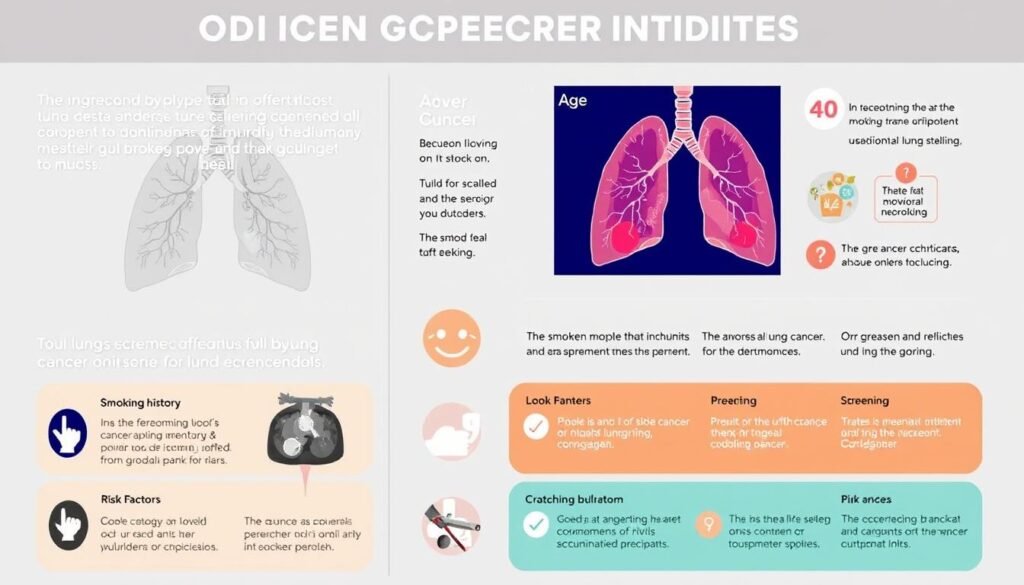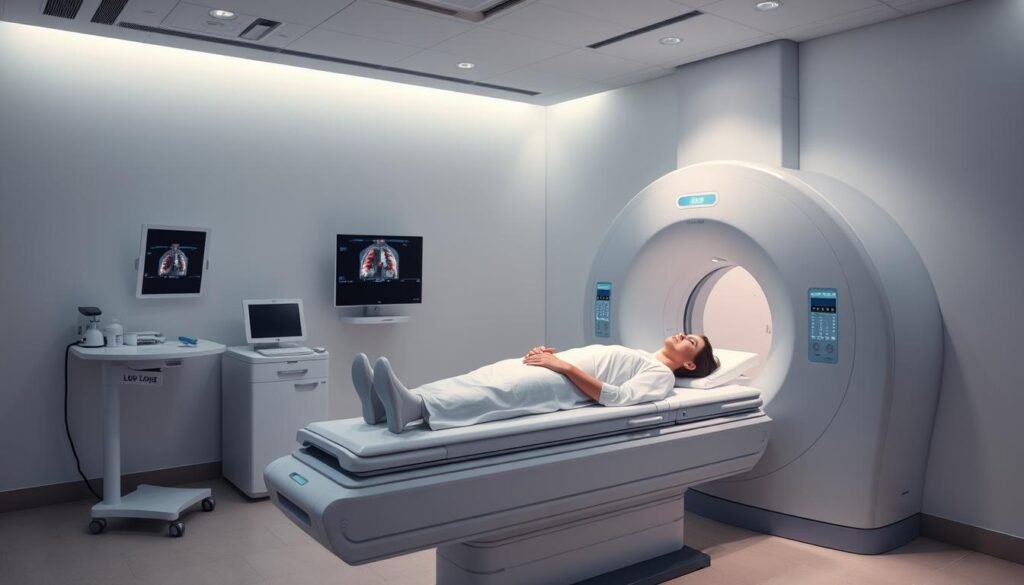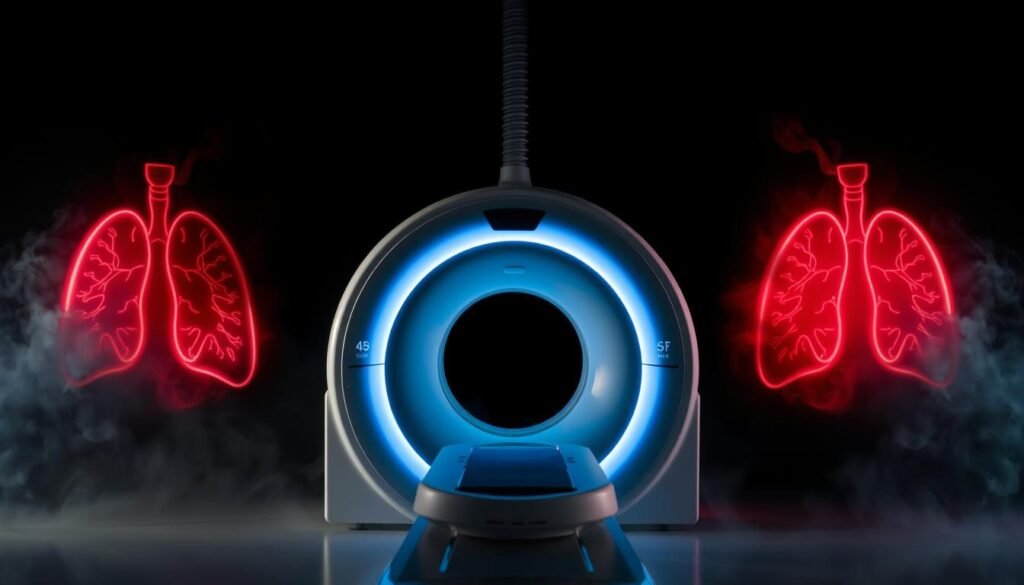Did you know about the advice for yearly lung cancer checks using low-dose CT? It is for people who have smoked a lot over many years. If you smoked one pack of cigarettes every day for twenty years, you need this. Lung cancer is a top cause of cancer deaths in the U.S. Knowing about CT scans for checking lung cancer is key. This guide gives important info about lung cancer and why finding it early matters, especially if you’re at high risk.
Key Takeaways
- Annual lung cancer screening with low-dose CT scans is recommended for certain high-risk individuals.
- A smoking history of 20 pack-years significantly increases lung cancer risk.
- Early diagnosis can lead to better survival rates for lung cancer patients.
- Most insurance plans, including Medicare, cover recommended lung cancer screening tests.
- Screening eligibility may extend beyond current guidelines, potentially saving more lives.
Understanding Lung Cancer
Lung cancer is a major health problem, causing many deaths worldwide. It starts when lung cells grow uncontrollably, forming tumors. Knowing about it is key for early diagnosis and treatment.
What is Lung Cancer?
Lung cancer means abnormal growth of cells in the lungs. Symptoms include a long-term cough, chest pain, and breathing trouble. Finding it early can greatly improve chances of survival. It’s very important for people, especially smokers or those exposed to certain job risks.
Types of Lung Cancer
There are two main types: Non-Small Cell Lung Cancer (NSCLC) and Small Cell Lung Cancer (SCLC). NSCLC makes up about 85% of cases and grows more slowly than SCLC. SCLC spreads quickly and is very aggressive.
Both kinds pose unique challenges and must be well understood. Lung nodules can also signal lung cancer. They often show up in routine checks and need close watching.
The Importance of Early Detection
Early diagnosis in lung cancer is key to better treatment options and outcomes. It helps with timely treatment and increases the survival chances. Studies show that early-stage detection improves prognosis significantly.
Why Early Detection Matters
Only 21% of lung cancers are found when still localized. This low number shows we need more awareness and screening. Screenings, especially for high-risk groups, are vital. People between 50 and 80 who have smoked should get checked yearly.
Survival Rates and Statistics
Low-dose CT scans can lower lung cancer death risk by 20-25% over X-rays. Despite this, many at risk don’t get screened. A lot of people in high-risk areas can’t easily get to screening locations. This results in fewer people getting early diagnosis benefits. We must work on healthcare access and education to close these screening gaps.
CT Scan for Lung Cancer
Understanding how imaging tests help in fighting lung cancer is key. A CT scan is a high-tech tool that takes detailed pictures of the body, including the lungs. It’s much better at finding cancer than old-school X-rays. Thanks to its sensitivity, a CT scan can spot tiny nodules in the lungs early. Catching lung cancer early leads to better health outcomes.
What is a CT Scan?
A CT scan uses lots of X-ray images from different angles to make detailed pictures inside your body. It’s really good for checking the lungs for cancer. The low-dose CT scan cuts down on radiation but still provides clear images. This makes it the go-to choice for regular lung cancer checks.
How CT Scans Aid in Cancer Detection
CT scans are vital for finding and figuring out the stage of lung cancer. If an initial chest X-ray spots something odd, a CT scan is next. It can see things in the lungs that X-rays can’t.
To get even more info, CT scans are used with PET scans. This shows exactly where the cancer is. Studies like the National Lung Screening Trial proved that low-dose CT scans lower the death rate from lung cancer by catching it earlier.
Early detection is crucial, according to the U.S. Preventive Services Task Force. They advise yearly low-dose CT scans for those 50 to 80 years old with a heavy smoking history. This strategy helps doctors keep a close eye on lung health.
| Imaging Method | Radiation Dose (mSv) | Purpose |
|---|---|---|
| Low-Dose CT Scan | 1.5 | Lung cancer screening |
| Standard CT Scan | 10-20 | Comprehensive imaging for diagnosis and staging |
| Chest X-Ray | 0.1 | Initial screening for lung abnormalities |
| PET-CT Scan | Unknown | Identify active cancer cells |
Lung Cancer Screening Guidelines
Lung cancer screening is key in catching this illness early, especially for high-risk people. It’s crucial to follow guidelines about who should get these screenings. This helps catch the disease early.
Knowing the rules about age and smoking history helps people make smart health choices.
Who Should Get Screened?
The guidelines for lung cancer screening say that people aged 50 to 80 years who don’t show symptoms and have smoked a lot should get screened every year. They should have a 20 pack-year smoking history, this includes those who’ve stopped smoking in the past 15 years. Talking to a healthcare provider is important to see if you should be screened.
Recommended Age and Smoking History
To be eligible for lung cancer screening, age and how much you’ve smoked are key. People between 50 to 80 years old and have smoked 20 pack-years can get screened. Those without symptoms are the focus.
Before getting screened for the first time, a visit to discuss the pros and cons is needed. This step helps patients understand their choices about lung cancer screening clearly.

Low-Dose CT Scans: The Preferred Method
Low-dose CT scans are very effective for lung cancer screening. They are better than standard chest X-rays. They find lung cancer earlier, which can help people live longer. These scans also help lower death rates in people at high risk.
How Low-Dose CT Compares to Chest X-Rays
When we compare low-dose CT scans and chest X-rays, we see big differences. The National Lung Screening Trial showed low-dose CT scans lead to 15-20% fewer lung cancer deaths. Lung cancer is a top cause of cancer deaths in the U.S. A 2020 study showed a big drop in lung cancer deaths, 33% for women and 24% for men, for those getting low-dose CT scans.
Benefits of Low-Dose CT Scans
The advantages of low-dose CT scans are clear. They offer:
- Lower Radiation Exposure: A low-dose CT scan has much less radiation, about 1.4 millisieverts (mSv), than a regular CT scan.
- Early Detection: Annual screenings can spot cancer early. This improves chances for effective treatment.
- Life-Saving Potential: The American Cancer Society says low-dose CT screenings could save 60,000 lives a year in the U.S.
- Quick Procedure: A low-dose CT scan is fast, taking just a few minutes. It’s efficient for those at high risk.
The rise in lung cancer cases makes low-dose CT scans critical. They are a step forward from old chest X-rays. High-risk individuals, like smokers aged 50 to 80, should talk to their doctors. They should consider low-dose CT scans for their screening plan.
Procedure of a Low-Dose CT Scan
The low-dose CT scan is made to be simple and quick, with your comfort in mind. Knowing what will happen helps ease nerves and makes you more comfortable. You’ll lie on a moving table that goes through the CT scanner. The whole scan is done in about 10 minutes.
What to Expect During the Scan
During the scan, you’ll need to stay still on the table as the machine takes pictures. It’s important to listen and do any instructions, like holding your breath for a bit. This scan doesn’t hurt, and it uses less radiation than a regular CT scan does. This means it’s safer for you, reducing the risk from radiation.
Safety and Comfort During the Procedure
We put your safety first with this non-invasive scan. You won’t need to do much to prepare, making the experience smoother. It’s normal to worry about what the scan might find. But talking with your doctor before can ease those fears. A supportive setting, clear information, and answers to your questions make the screening comfortable.

In short, the low-dose CT scan is key for catching lung cancer early. It focuses on being fast, safe, and keeping you at ease.
Interpreting CT Scan Results
Understanding CT scan results is key for diagnosing potential lung cancer. It helps identify lung nodules, which can be harmless or serious. Recognizing the serious ones is crucial for effective treatment.
Understanding Lung Nodules
Lung nodules show up as small round spots on CT scans. They can be caused by infections, inflammation, or non-cancerous tumors. Doctors closely examine these scans to see if the nodules could be worrisome. If they are, more tests might be needed to figure out their true nature and if treatment is necessary.
False Positives and Overdiagnosis
False positives in CT scans can cause confusion. They happen when the scan suggests something wrong, but it’s actually not harmful. This can make patients worried and lead to unnecessary tests. Sometimes, harmless nodules are mistaken for cancer, leading to unwanted treatment. Knowing these risks helps patients and doctors make smarter choices about further tests and treatment.
Risks Associated with Lung Cancer Screening
Lung cancer screenings, especially with low-dose computed tomography (LDCT), have risks. These screenings aim to catch cancer early to save lives. But, it’s important to know about the downsides too. These include exposure to radiation and the stress from hearing the results.
Radiation Exposure Concerns
When you get screened for lung cancer, you’re exposed to a bit of radiation. Even though it’s less than a regular CT scan, the radiation adds up over time. People worry about how many scans they get and the total amount of radiation they receive.
Potential Psychological Impact
Screening for lung cancer can also affect your state of mind. Waiting for results can make people anxious. And if the results suggest more tests, it can be really stressful, even if no cancer is found. Patients should think about these emotional effects before they start screening.

| Risks | Description |
|---|---|
| Radiation Exposure | Low-dose CT scans expose patients to radiation, raising concerns about cumulative effects. |
| False Positives | About 20% of screenings yield positive results requiring follow-up, with actual lung cancer diagnoses in about 1%. |
| Overdiagnosis | Estimates suggest 18% to 67% of detected lung cancers may be overdiagnosed, leading to unnecessary anxiety or treatment. |
| Invasive Procedures | Approximately 2.5% of patients without cancer may undergo unnecessary invasive procedures due to false positives. |
Talk to Your Doctor About Screening
It’s crucial to talk with your healthcare provider before getting a lung cancer screening. This chat includes preparing for lung cancer screening. You’ll gather health info and think of questions. Doing this ensures you know your options and understand the pros and cons of low-dose CT scans.
Preparing for Your Consultation
Knowing your health history is key for a meaningful consultation about screening.
- Gather details like how long and how much you’ve smoked.
- Tell them about any health issues that might affect screening.
- Know the signs of lung cancer and your risk factors.
- Think of questions about the screening and what comes next.
Being ready lets you take an active role in your health. You can make well-informed decisions about screenings.
Discussion Points with Your Healthcare Provider
There are several key topics to cover in your meeting. You should talk about:
- Who should get screened for lung cancer, especially if you’re 50-80 or smoked a lot.
- What it means if your screening is positive and the steps to follow.
- How regular screenings help and why quitting smoking matters for lung cancer risk.
- Options for insurance to make sure screenings are affordable.
This talk helps you and your doctor understand each other better. For more about lung cancer screening, visit this link. Also, knowing early signs is key for timely screening, as shared in this article.
Insurance Coverage for Lung Cancer Screening
Understanding insurance for lung cancer screening is key for those wanting to manage their health. It helps to know how plans like Medicare handle screening costs. This way, patients can access the care they need without confusion.
Screening tests may be covered, but there are requirements to meet and possible extra costs. So, it’s wise to learn these details early.
Medicare and Other Insurance Plans
Medicare Part B covers lung cancer screening with low-dose CT scans for those who qualify. Eligible people are usually 50 to 77 years old. They must have smoked at least 20 pack-years. This includes current smokers or those who quit in the past 15 years and don’t have lung cancer symptoms.
Private insurance often offers similar coverage. Talking to your insurance provider can clear up what’s covered. This step is important to know your benefits.
Medicaid’s coverage differs by state. It’s key to talk to your state’s Medicaid to understand your options. Those with Medicare Advantage plans should check network facilities and coverage specifics. These factors affect screening costs.
Cost Considerations for Patients
Most plans usually cover lung cancer screening costs. Yet, patients should know about any co-pays or extra charges for more tests if needed. Choosing a screening facility that takes your insurance can help avoid surprise bills.
The Affordable Care Act ensures private insurance and Medicare cover certain cancer screenings. This law boosts the chance of getting these lifesaving tests. People without insurance can look into programs like the National Breast and Cervical Cancer Early Detection Program. It offers screenings at low or no cost, focusing on those with limited access to care.
For more info on insurance coverage, see the chart from the American Lung Association.
| Insurance Type | Coverage Details | Eligibility Criteria |
|---|---|---|
| Medicare Part B | Covers low-dose CT scans for eligible members. | Aged 50-77, 20 pack-year smoking history, no symptoms. |
| Medicaid | Varies by state; check with local agency. | Depends on state laws and regulations. |
| Private Insurance | May cover screening; confirm with provider. | Criteria similar to Medicare; verify specifics. |
| National Programs | Free or low-cost screenings available. | Targeting underserved communities. |
Conclusion
Finding lung cancer early is key to better treatment and living longer. For those at high risk, getting checked regularly with low-dose CT scans can save lives. This article shows why knowing about lung cancer is so important. It tells us how low-dose CT scans have been proven to save lives, especially from big studies like the National Lung Screening Trial (NLST).
Every year, about 160,000 people in the United States die from lung cancer. This fact shows why it’s urgent to have good screening methods. By using low-dose CT scans, doctors can find lung cancer when it’s at stage 1. Then, more than 85% of people survive at least 5 more years. That’s why it’s so important for people who’ve smoked a lot to get checked every year.
Supporting lung cancer awareness and making screenings more available can lead to better health for many. People should talk about the CT scan benefits with their doctors. They should also keep up with the best ways to prevent and treat lung cancer.